The document discusses minimum spanning trees (MST) and two algorithms for finding them: Prim's algorithm and Kruskal's algorithm. It begins by defining an MST as a spanning tree (connected acyclic graph containing all vertices) with minimum total edge weight. Prim's algorithm grows a single tree by repeatedly adding the minimum weight edge connecting the growing tree to another vertex. Kruskal's algorithm grows a forest by repeatedly merging two components via the minimum weight edge connecting them. Both algorithms produce optimal MSTs by adding only "safe" edges that cannot be part of a cycle.
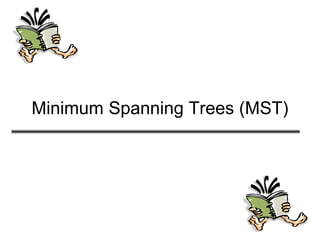
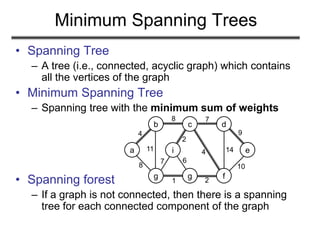

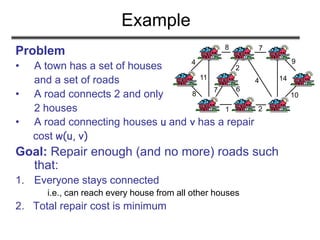
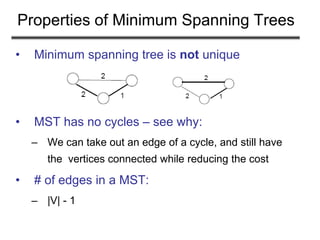

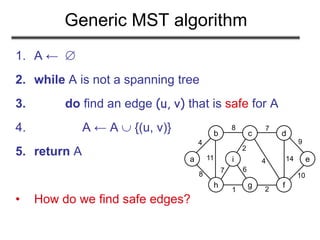

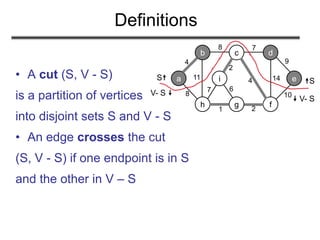


![How to Find Light Edges Quickly?
Use a priority queue Q:
• Contains vertices not yet
included in the tree, i.e., (V – VA)
– VA = {a}, Q = {b, c, d, e, f, g, h, i}
• We associate a key with each vertex v:
key[v] = minimum weight of any edge (u, v)
connecting v to VA
a
b c d
e
h g f
i
4
8 7
8
11
1 2
7
2
4 14
9
10
6
w1
w2
Key[a]=min(w1,w2)
a](https://image.slidesharecdn.com/minimumspanningtree-180514053329/85/Minimum-spanning-tree-12-320.jpg)
![How to Find Light Edges Quickly?
(cont.)
• After adding a new node to VA we update the weights of all
the nodes adjacent to it
e.g., after adding a to the tree, k[b]=4 and k[h]=8
• Key of v is if v is not adjacent to any vertices in VA
a
b c d
e
h g f
i
4
8 7
8
11
1 2
7
2
4 14
9
10
6](https://image.slidesharecdn.com/minimumspanningtree-180514053329/85/Minimum-spanning-tree-13-320.jpg)
![Example
0
Q = {a, b, c, d, e, f, g, h, i}
VA =
Extract-MIN(Q) a
a
b c d
e
h g f
i
4
8 7
8
11
1 2
7
2
4 14
9
10
6
a
b c d
e
h g f
i
4
8 7
8
11
1 2
7
2
4 14
9
10
6
key [b] = 4 [b] = a
key [h] = 8 [h] = a
4 8
Q = {b, c, d, e, f, g, h, i} VA = {a}
Extract-MIN(Q) b
4
8](https://image.slidesharecdn.com/minimumspanningtree-180514053329/85/Minimum-spanning-tree-14-320.jpg)
![4
8
8
Example
a
b c d
e
h g f
i
4
8 7
8
11
1 2
7
2
4 14
9
10
6
key [c] = 8 [c] = b
key [h] = 8 [h] = a - unchanged
8 8
Q = {c, d, e, f, g, h, i} VA = {a, b}
Extract-MIN(Q) c
a
b c d
e
h g f
i
4
8 7
8
11
1 2
7
2
4 14
9
10
6
key [d] = 7 [d] = c
key [f] = 4 [f] = c
key [i] = 2 [i] = c
7 4 8 2
Q = {d, e, f, g, h, i} VA = {a, b, c}
Extract-MIN(Q) i
4
8
8
7
4
2](https://image.slidesharecdn.com/minimumspanningtree-180514053329/85/Minimum-spanning-tree-15-320.jpg)
![Example
a
b c d
e
h g f
i
4
8 7
8
11
1 2
7
2
4 14
9
10
6
key [h] = 7 [h] = i
key [g] = 6 [g] = i
7 4 6 8
Q = {d, e, f, g, h} VA = {a, b, c, i}
Extract-MIN(Q) f
a
b c d
e
h g f
i
4
8 7
8
11
1 2
7
2
4 14
9
10
6
key [g] = 2 [g] = f
key [d] = 7 [d] = c unchanged
key [e] = 10 [e] = f
7 10 2 8
Q = {d, e, g, h} VA = {a, b, c, i, f}
Extract-MIN(Q) g
4 7
8 4
8
2
7 6
4 7
7 6 4
8
2
2
10](https://image.slidesharecdn.com/minimumspanningtree-180514053329/85/Minimum-spanning-tree-16-320.jpg)
![Example
a
b c d
e
h g f
i
4
8 7
8
11
1 2
7
2
4 14
9
10
6
key [h] = 1 [h] = g
7 10 1
Q = {d, e, h} VA = {a, b, c, i, f, g}
Extract-MIN(Q) h
a
b c d
e
h g f
i
4
8 7
8
11
1 2
7
2
4 14
9
10
6
7 10
Q = {d, e} VA = {a, b, c, i, f, g, h}
Extract-MIN(Q) d
4 7
10
7 2 4
8
2
1
4 7
10
1 2 4
8
2](https://image.slidesharecdn.com/minimumspanningtree-180514053329/85/Minimum-spanning-tree-17-320.jpg)
![Example
a
b c d
e
h g f
i
4
8 7
8
11
1 2
7
2
4 14
9
10
6
key [e] = 9 [e] = f
9
Q = {e} VA = {a, b, c, i, f, g, h, d}
Extract-MIN(Q) e
Q = VA = {a, b, c, i, f, g, h, d, e}
4 7
10
1 2 4
8
2 9](https://image.slidesharecdn.com/minimumspanningtree-180514053329/85/Minimum-spanning-tree-18-320.jpg)
![PRIM(V, E, w, r)
1. Q ←
2. for each u V
3. do key[u] ← ∞
4. π[u] ← NIL
5. INSERT(Q, u)
6. DECREASE-KEY(Q, r, 0) ► key[r] ← 0
7. while Q
8. do u ← EXTRACT-MIN(Q)
9. for each v Adj[u]
10. do if v Q and w(u, v) < key[v]
11. then π[v] ← u
12. DECREASE-KEY(Q, v, w(u, v))
O(V) if Q is implemented
as a min-heap
Executed |V| times
Takes O(lgV)
Min-heap
operations:
O(VlgV)
Executed O(E) times total
Constant
Takes O(lgV)
O(ElgV)
Total time: O(VlgV + ElgV) = O(ElgV)
O(lgV)](https://image.slidesharecdn.com/minimumspanningtree-180514053329/85/Minimum-spanning-tree-19-320.jpg)
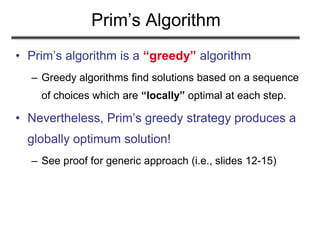







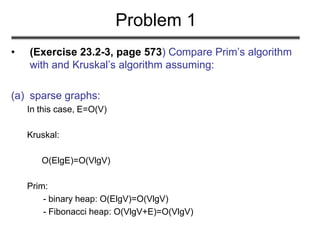

![(Exercise 23.2-4, page 574): Analyze the
running time of Kruskal’s algorithm when
weights are in the range [1 … V]
Problem 2](https://image.slidesharecdn.com/minimumspanningtree-180514053329/85/Minimum-spanning-tree-30-320.jpg)

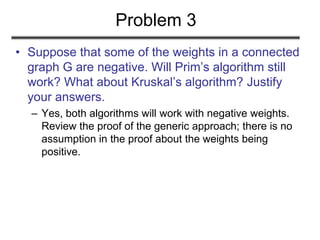

![PRIM(V, E, w, r)
1. Q ←
2. for each u V
3. do key[u] ← ∞
4. π[u] ← NIL
5. INSERT(Q, u)
6. DECREASE-KEY(Q, r, 0) ► key[r] ← 0
7. while Q
8. do u ← EXTRACT-MIN(Q)
9. for each v Adj[u]
10. do if v Q and w(u, v) < key[v]
11. then π[v] ← u
12. DECREASE-KEY(Q, v, w(u, v))
O(V) if Q is implemented
as a min-heap
Executed |V| times
Takes O(lgV)
Min-heap
operations:
O(VlgV)
Executed O(E) times
Constant
Takes O(lgV)
O(ElgV)
Total time: O(VlgV + ElgV) = O(ElgV)
O(lgV)](https://image.slidesharecdn.com/minimumspanningtree-180514053329/85/Minimum-spanning-tree-34-320.jpg)
![PRIM(V, E, w, r)
1. Q ←
2. for each u V
3. do key[u] ← ∞
4. π[u] ← NIL
5. INSERT(Q, u)
6. DECREASE-KEY(Q, r, 0) ► key[r] ← 0
7. while Q
8. do u ← EXTRACT-MIN(Q)
9. for (j=0; j<|V|; j++)
10. if (A[u][j]=1)
11. if v Q and w(u, v) < key[v]
12. then π[v] ← u
13. DECREASE-KEY(Q, v, w(u, v))
O(V) if Q is implemented
as a min-heap
Executed |V| times
Takes O(lgV)
Min-heap
operations:
O(VlgV)
Executed O(V2) times total
Constant
Takes O(lgV) O(ElgV)
Total time: O(VlgV + ElgV+V2) = O(ElgV+V2)
O(lgV)](https://image.slidesharecdn.com/minimumspanningtree-180514053329/85/Minimum-spanning-tree-35-320.jpg)

